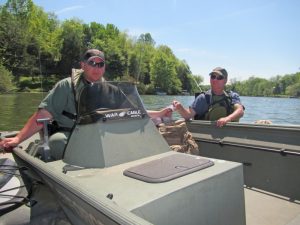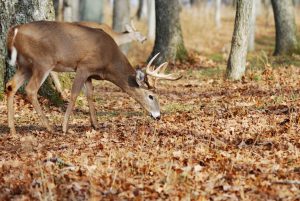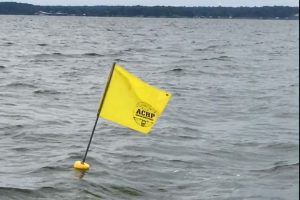
Photo: Kentucky Department Fish and Wildlife
The sun sets earlier each day and the kids are back in school. Summer is all but over. This inevitability prompts many to visit lakes, rivers and streams to get in that last weekend of the summer boating season during the Labor Day holiday weekend.
“Our busiest weekend of the year,” said Maj. Shane Carrier, assistant director of law enforcement for the Kentucky Department of Fish and Wildlife Resources. “Traditionally, Labor Day marks the end of the boating season.”
The crowded conditions common on this holiday weekend make observance of simple boating safety procedures vital to a safe weekend for everyone.
The law requires each passenger in a vessel to have a personal floatation device, commonly called a lifejacket, readily accessible for use. “I cannot stress enough the importance of wearing a lifejacket,” Carrier said. He explained that a lifejacket stored in a compartment or stuffed under a seat is not readily accessible.
“You must be able to get to the lifejacket quickly when you need it,” Carrier said.
Sales of paddlecraft such as kayaks, canoes and stand up paddleboards are booming, but wearing a lifejacket while paddling is of paramount importance for safety.
“Paddlecraft use is growing by leaps and bounds across Kentucky,” Carrier said. “Many paddlecraft users overlook the safety aspect. Paddlecraft are slow and do not have a motor. This lulls people into a false sense of security. I strongly suggest wearing a lifejacket at all times when operating a paddlecraft.”
Carrier said he sees many stand up paddleboard operators with their lifejacket strapped to the front of the paddleboard. “That doesn’t work well if you fall over and hit your head,” he said.
Paddlecraft now line the front of sporting goods, department and hardware stores awaiting a buyer.
“People buy paddlecraft with no training or experience and get in over their head, especially in moving water,” Carrier said. “Leave a float plan with a loved one and get a dry bag to store a charged cell phone on your boat in case you get in trouble.”
Carrier said the law enforcement division spent many hours this year on search and rescue efforts to look for paddlers. “We’ve had quite a few misjudge their take out or how long it takes to paddle there,” he said. “They must know how long it takes to get the float completed. If there is low water and you have to drag a boat over riffles and shoals, it takes time.”
Avoiding alcoholic drinks is one of the smartest safety decisions boaters can make. “Drinking in public is against the law in Kentucky and our waterways are public places,” Carrier said.
The combination of hours in the sun, heat and movement of the boat can induce a mild stupor called boater’s fatigue. “Alcohol intensifies boater’s fatigue,” Carrier said. “This condition can lead to poor decisions on the water.”
Carrier stressed the importance of checking safety equipment to ensure it is in good working order.
A boat with a motor must have a working fire extinguisher on board at all times. “Store the fire extinguisher away from the engine,” Carrier said. “On some boats with inboard-outboard motors, the fire extinguisher is mounted in the engine compartment. If you have a fire, you will burn yourself trying to get to it.”
All vessels over 16 feet in length must have a hand, mouth or power-operated signaling device such as a loud whistle or boat horn. They must also have working red and green navigation lights in the bow of the vessel and a steady white light visible from 360 degrees in the stern.
Boat operators must display these lights from sunset to sunrise in areas where other boats navigate, whether the boat is under power or anchored.
Some boaters mistakenly believe you do not need working navigation lights if you only operate the boat during daylight hours. Mechanical failures, dead batteries or getting lost can prevent a boat from getting back to the dock or ramp before nightfall when you must display these lights. Therefore, lights must be in working condition no matter when you operate the boat.
“You need a light at night so you don’t get run over by another boat,” Carrier said.
Each vessel must have a Type IV throwable personal floatation device such as a float cushion or ring readily accessible for use.
“Although this isn’t boating related, we’ve had multiple people this year drown from swimming,” Carrier said. “People, especially teenagers, try to swim beyond their ability and misjudge the distance. Peer pressure can induce them to try to swim across a large cove and then it is too late.”
Obey these simple safeguards and make the Labor Day weekend memorable for the right reasons.

Photo: Kevin Kelly/Kentucky Department Fish and Wildlife
A white-tailed deer from western Kentucky is the state’s first confirmed case of hemorrhagic disease this year.
Murray State University’s Breathitt Veterinary Center recently confirmed to the Kentucky Department of Fish and Wildlife Resources that a deceased female deer recovered from Graves County tested positive for hemorrhagic disease, sometimes referred to as “blue tongue” or EHD. Kentucky Fish and Wildlife is investigating other possible cases involving 22 deer in 11 counties and expects the number could grow in the coming weeks.
“Hemorrhagic disease cannot be transmitted to people or pets,” said Dr. Christine Casey, state wildlife veterinarian for Kentucky Fish and Wildlife. “It is caused by two different viruses: epizootic hemorrhagic disease virus (EHD) and bluetongue virus. These viruses are transmitted to deer by small biting flies, also called no-see-ums.”
Kentucky experiences localized hemorrhagic disease outbreaks each year. More regionally widespread and statewide outbreaks can occur in cycles of five years or longer. A significant regional outbreak of hemorrhagic disease affected many east Kentucky counties two years ago. Far western Kentucky endured an outbreak in 2012, and the last statewide outbreak occurred in 2007.
Outbreaks of hemorrhagic disease generally last from late summer until the first hard frost of the year kills the virus-carrying flies.
Hemorrhagic disease has been present in the United States for more than 60 years. It is not the same as chronic wasting disease (CWD), an always fatal neurological disease that affects white-tailed deer, elk and other members of the deer family. Chronic wasting disease has never been detected in Kentucky.
One main difference between the diseases is that some deer do survive hemorrhagic disease outbreaks and produce protective antibodies, which can be passed to their young. Protective antibodies are major contributors to herd immunity and one reason why Kentucky sees cyclic outbreaks of hemorrhagic disease, rather than a higher prevalence every year.
In Kentucky and across the Midwest, deer that die from hemorrhagic disease typically die within 24 to 36 hours after being bitten by an infected insect. People often find carcasses of deer that have died from the disease around water, and because they died rapidly these animals can appear well fed or otherwise normal. Sometimes there are several carcasses in one area.
While elk in Appalachian Kentucky also contract hemorrhagic disease from insect bites, they usually show no outward signs of illness and death does not occur.
“Kentucky’s archery deer hunting season opens early next month,” said Gabe Jenkins, deer and elk program coordinator with Kentucky Fish and Wildlife. “The department is asking hunters and others to be on the lookout for sick looking deer.
“Deer with hemorrhagic disease can be more susceptible to other diseases. For that reason, the department always cautions against eating the meat from a deer that doesn’t appear to be healthy.”
Through Aug. 21, Kentucky Fish and Wildlife had received reports of suspected hemorrhagic disease in 22 deer. The reports originated from Anderson, Carroll, Christian, Graves, Greenup, Harrison, Meade, Oldham, Trimble, Scott and Shelby counties. The only confirmed case was the Graves County deer. Kentucky Fish and Wildlife is awaiting test results on others.
People can go online now to report to Kentucky Fish and Wildlife suspected cases of hemorrhagic disease in dead or dying deer. The digital form is available at fw.ky.gov under the “Important Info” tab. It takes only a few minutes to complete but provides important data for estimating the scale of the outbreak and for communicating with the public.
Reports also can be submitted by phone. Kentucky Fish and Wildlife staffs a toll-free number weekdays from 8 a.m. to 4:30 p.m. (Eastern). The number is 1-800-858-1549. In addition to their name and contact information, callers will be asked to provide the following about their observation: county and date, number of deer found, and whether the deer were sick or recently deceased.
Information reported to Kentucky Fish and Wildlife through these channels will help the department create maps so the public can see the extent of the disease’s spread.
For more information about hemorrhagic disease, visit the Kentucky Fish and Wildlife website at fw.ky.gov and search for the phrase, “Hemorrhagic Disease.”

Photo: Louisville Metro Council
As August comes to a close, an Old Louisville tradition is once again ready to help ease out the summer with some great music in a very nice setting. President David James (D-6) is once again presenting “Jazz in Central Park” on Sunday, August 25th.
“I feel many people look forward to this perfect way to enjoy a Sunday afternoon. There is a wide variety of artists who specialize in jazz and entertainment, and best of all its free and open to any and every one,” says James. “Bring some friends or the family to Central Park and sit back and listen to some of the best artists in jazz the area has to offer.”
“Jazz in Central Park” will be held from 5:00pm to 8:00pm. This year’s event is hosted by Dawne Gee of WAVE TV and comedian Jason English.
The following artists will be featured this year:
- Kim Scott & TRI+ADD
- Maestro J
- ZLynn
- Nexlevel
- Annalie Durbin Project
Local Food Vendors will also be on hand for the evening.
“Please come join us and take advantage of a nice way to end a summer weekend in Old Louisville’s Central Park,” says James. “It will be a great night to kick back and enjoy your surroundings.”
Joining President James as sponsors of this year’s event are Brown-Forman, Clariant, Walmart, Genscape, Rumpke and Kosair Charities.
Central Park is located at1340 South 4th Street in Old Louisville.
For more information about “Jazz in Central Park”, contact Councilman James’ office at 574-1106.
 Seven Kentucky State Parks were recognized in Kentucky Living magazine’s “Best in Kentucky” Awards announced Thursday at the 2019 Kentucky State Fair: My Old Kentucky Home, Cumberland Falls, John James Audubon, Green River Lake, Dale Hollow Lake, Natural Bridge and Barren River Lake.
Seven Kentucky State Parks were recognized in Kentucky Living magazine’s “Best in Kentucky” Awards announced Thursday at the 2019 Kentucky State Fair: My Old Kentucky Home, Cumberland Falls, John James Audubon, Green River Lake, Dale Hollow Lake, Natural Bridge and Barren River Lake.
“We’re proud of all of our Kentucky State Parks and the people who work there,” Parks Commissioner Donnie Holland said. “We appreciate being recognized by our guests.”
My Old Kentucky Home State Park in Bardstown received first place in the historic site category. The centerpiece of the park is Federal Hill, a mansion completed in 1818 by the Rowan family. Tours of the home and special events are offered throughout the year. The park also has a golf course and campground.
Cumberland Falls State Resort Park near Corbin received two 2nd place awards for long weekend getaway and day trip. Cumberland Falls is the home of a beautiful waterfall, 125-feet wide and 65-feet high, that also produces a “moonbow” during a full moon. The park has a lodge, cottages, restaurant, campground, hiking trails and many other recreational activities.
Other Kentucky State Parks recognized were:
- John James Audubon State Park in Henderson received 2nd place for museum.
- Green River Lake State Park near Campbellsville received 2nd place for camping spot.
- Dale Hollow Lake State Resort Park near Burkesville received 3rd place for golf course and for houseboating lake.
- Natural Bridge State Resort Park at Slade got 3rd place for place for adventure.
- Barren River Lake State Resort Park at Lucas received a 3rd place award for public hunting/fishing area.
For more information about these and other Kentucky State Parks, visit www.parks.ky.gov
 Meeting planners looking to ‘connect’ with peers and suppliers will be assembling in Louisville August 26-28 for Connect Marketplace, a leading tradeshow in the meetings, events, travel and tourism industry. Approximately 4,000 meeting professionals will be attending Connect Marketplace around the one-year anniversary of the renovated and re-opened Kentucky International Convention Center (KICC).
Meeting planners looking to ‘connect’ with peers and suppliers will be assembling in Louisville August 26-28 for Connect Marketplace, a leading tradeshow in the meetings, events, travel and tourism industry. Approximately 4,000 meeting professionals will be attending Connect Marketplace around the one-year anniversary of the renovated and re-opened Kentucky International Convention Center (KICC).
The opening address will be given by retired American competitive swimmer Michael Phelps, the most decorated Olympian in history with 28 medals. To conclude the conference, the closing keynote will be delivered by Academy Award-winning actress Nicole Kidman, a Goodwill Ambassador for UN Women, focusing on raising awareness of ending violence against women and girls.
“We are thrilled to have the opportunity to once again showcase the city of Louisville to such an important audience,” said Karen Williams, President and CEO of Louisville Tourism. “Hosting Connect Marketplace 2019 will support our mission to continue attracting world-class industry tradeshows in Louisville. This will be the second time Connect Marketplace has been to Louisville, and we plan to take every opportunity to show the best our city has to offer, including the explosion of tourism infrastructure over the last decade.”
Connect Marketplace organizers committed to hosting this show in Louisville in the fall of 2017 after confirming it would be ready before 2019. They last met in Louisville in 2010. The estimated economic impact to Louisville from the three-day conference is $4.4 million, however the city stands to benefit additionally from the prospective future convention bookings that occur as a result of showcasing Louisville’s convention package to these key site selection decision makers.
“We are so pleased to be the host city for the 2019 Connect Marketplace,” said Louisville Mayor Greg Fischer. “This is a time of great transformation for our city, and we’re proud to host the meeting industry’s top event professionals and give these decision-makers a front-row seat to the nearly $1 billion in tourism-based infrastructure improvements underway here.”
Louisville Tourism planned several initiatives to help the city stand out. Some of the key elements of the welcome program include sponsoring a pink-out opening party at Churchill Downs for breast cancer awareness, chalk art downtown and arranging free artist entertainment outside the convention center in the form of buskers. The buskers are part of the Art in Lou pilot program in partnership with the Fund for the Arts to provide artists with paid opportunities to perform for the community in public spaces, providing a welcoming, lively atmosphere for visitors and residents.
 Commercial anglers on Kentucky and Barkley lakes are deploying indicator flags to mark the locations of their nets.
Commercial anglers on Kentucky and Barkley lakes are deploying indicator flags to mark the locations of their nets.
“We want to make anglers and recreational boaters aware of ongoing commercial angling and net locations,” said Jessica Morris, fisheries biologist with the Kentucky Department of Fish and Wildlife Resources.
“These bright yellow flags are visible for a mile. While nets are generally set 3-feet underneath the surface, boaters still should not go between flags or use them for skiing buoys because of the risk of entanglement.”
The Kentucky Fish and Wildlife Foundation purchased about 100 flags and the materials to attach them to the nets.
This spring, the Kentucky Fish and Wildlife Commission voted to allow commercial netting during summer weekends as part of the ongoing effort to control numbers of invasive Asian carp in Kentucky and Barkley lakes. Commercial anglers previously were restricted to netting during the weekdays in summer.
Asian carp outcompete native fish for food. Silver carp, one of the Asian carp species, can be hazardous to boaters as they jump out of the water as a boat approaches.
The net indicator flags are part of a collaborative effort between the department and Kentucky Fish and Wildlife Foundation to avoid user conflicts on the lakes. Nets may be deployed day or night, and not all will be marked.
So far this year, commercial anglers have netted 2.8 million pounds of Asian carp from Kentucky waterways, more than double the 1.1 million pounds taken by the same time in 2018. Morris said approximately 80 percent of the harvest comes from Lake Barkley.
Kentucky Fish and Wildlife is working with commercial anglers and processors to develop markets for Asian carp.
As part of the effort to control Asian carp, construction is underway on a deterrent system designed to thwart the fish from entering a boating lock chamber into Lake Barkley. The device, known as a bio-acoustic fish fence, could be operational by fall.
The Governor’s Scholars Program, within the Education and Workforce Development Cabinet (EWDC), recognized 1,024 outstanding Kentucky high school students, representing 118 counties, for completing the 37th Governor’s Scholars Summer Program.
The Governor’s Scholars Program is a summer residential program for outstanding high school students focused on enhancing Kentucky’s next generation of civic and economic leaders through educational and career opportunities.
“The Governor’s Scholars Program is a nationally recognized program that has helped foster the next generation of Kentucky leaders,” said EWDC Secretary Derrick Ramsey. “For 37 years, GSP has provided unique opportunities for the high school students to exchange ideas, learn new disciplines, and interact with peers from different regions of our state.”
To participate in the program, a statewide selection committee chooses participants based upon nominations submitted by each Kentucky school district. Selection criteria is based upon academic records and test scores, teacher and community recommendations, extracurricular and service activities, and a writing entry. The program is available at no cost to eligible students.
This year, the program was hosted at Centre College from June 16 – July 20; Morehead State University from June 22 – July 26; and Bellarmine University from June 23 – July 27.
Scholars balanced a busy academic schedule in the sciences, mathematics, social sciences, humanities and the arts with a variety of co-curricular and residential activities. They also participated in community projects, seminars, and other student-initiated activities throughout the five week program.
To learn more about the Governor’s Scholars Program, visit https://gsp.ky.gov/Pages/index.aspx.
 Weather
Weather Traffic
Traffic @LouisvilleDispatch
@LouisvilleDispatch @LouisvilleDisp
@LouisvilleDisp Subscribe
Subscribe
